oil level PEUGEOT 2008 2016 Owners Manual
[x] Cancel search | Manufacturer: PEUGEOT, Model Year: 2016, Model line: 2008, Model: PEUGEOT 2008 2016Pages: 450, PDF Size: 14.16 MB
Page 12 of 450
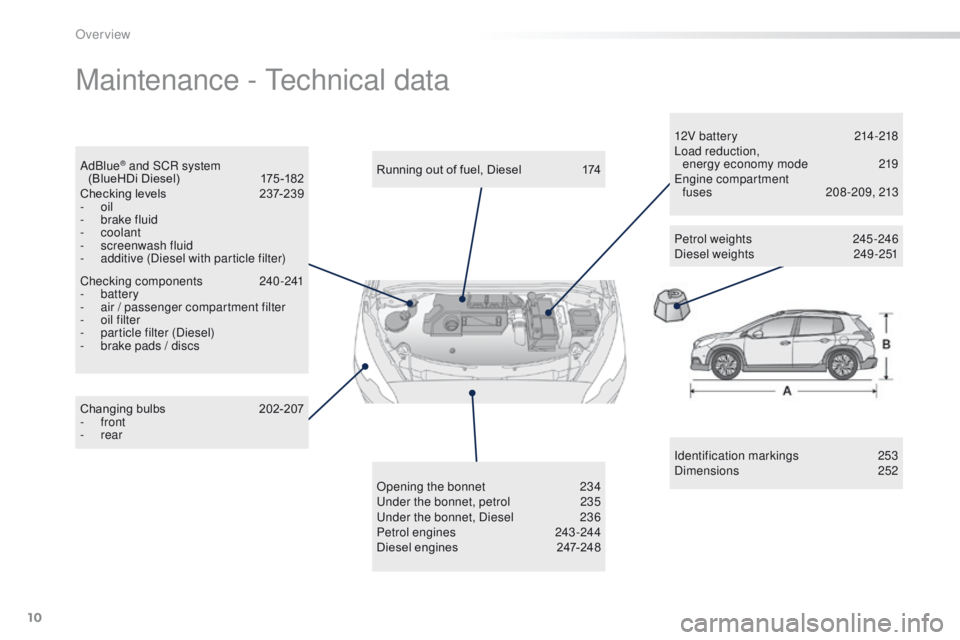
10
2008_en_Chap00b_vue-ensemble_ed01-2016
Maintenance - Technical data
Identification markings 253
Dimensions 252
Changing bulbs
2
02-207
-
front
-
rear Running out of fuel, Diesel
1
74
Opening the bonnet
2
34
Under the bonnet, petrol
2
35
Under the bonnet, Diesel
2
36
Petrol engines
2
43 -244
Diesel engines
2
47-248 12V batter y
21
4 -218
Load reduction, energy economy mode
2
19
Engine compartment fuses
2
08 -209, 213
Petrol weights
2
45 -246
Diesel weights
2
49-251
AdBlue
® and SCR system
(BlueHDi Diesel) 1 75 -182
Checking levels
23
7-239
-
oil
-
b
rake fluid
-
coolant
-
s
creenwash fluid
-
a
dditive (Diesel with particle filter)
Checking components
2
40-241
-
battery
-
a
ir / passenger compartment filter
-
o
il filter
-
p
article filter (Diesel)
-
b
rake pads / discs
Over view
Page 15 of 450
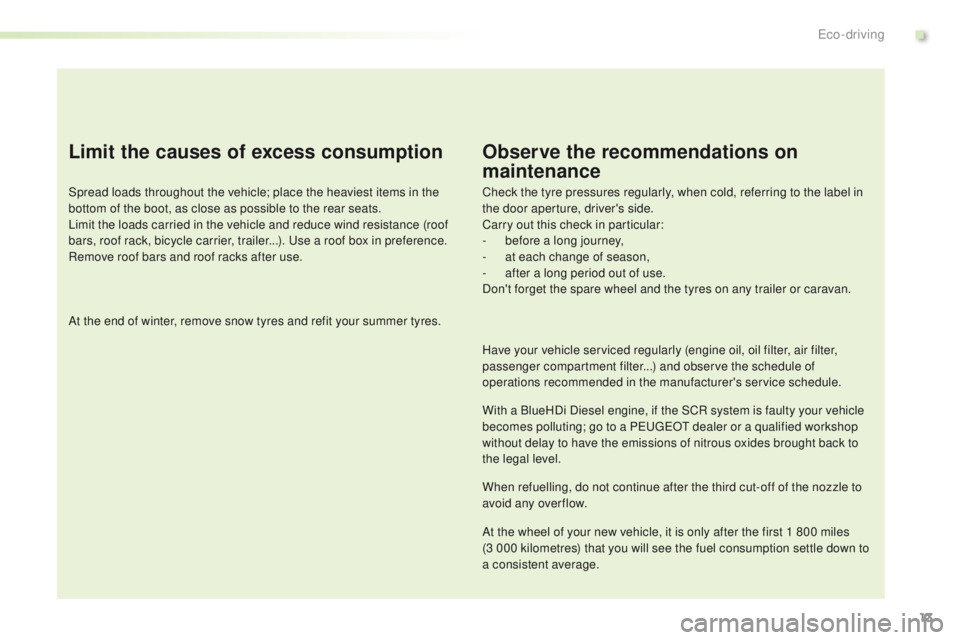
13
2008_en_Chap00c_eco-conduite_ed01-2016
Limit the causes of excess consumption
Spread loads throughout the vehicle; place the heaviest items in the
bottom of the boot, as close as possible to the rear seats.
Limit the loads carried in the vehicle and reduce wind resistance (roof
bars, roof rack, bicycle carrier, trailer...). Use a roof box in preference.
Remove roof bars and roof racks after use.
At the end of winter, remove snow tyres and refit your summer tyres.
Observe the recommendations on
maintenance
Check the tyre pressures regularly, when cold, referring to the label in
the door aperture, driver's side.
Carry out this check in particular:
-
b
efore a long journey,
-
a
t each change of season,
-
a
fter a long period out of use.
Don't forget the spare wheel and the tyres on any trailer or caravan.
Have your vehicle serviced regularly (engine oil, oil filter, air filter,
passenger compartment filter...) and observe the schedule of
operations recommended in the manufacturer's service schedule.
With a BlueHDi Diesel engine, if the SCR system is faulty your vehicle
becomes polluting; go to a PEUGEOT dealer or a qualified workshop
without delay to have the emissions of nitrous oxides brought back to
the legal level.
When refuelling, do not continue after the third cut-off of the nozzle to
avoid any over flow.
At the wheel of your new vehicle, it is only after the first 1 800 miles
(3 000 kilometres) that you will see the fuel consumption settle down to
a consistent average.
.
Eco-driving
Page 16 of 450
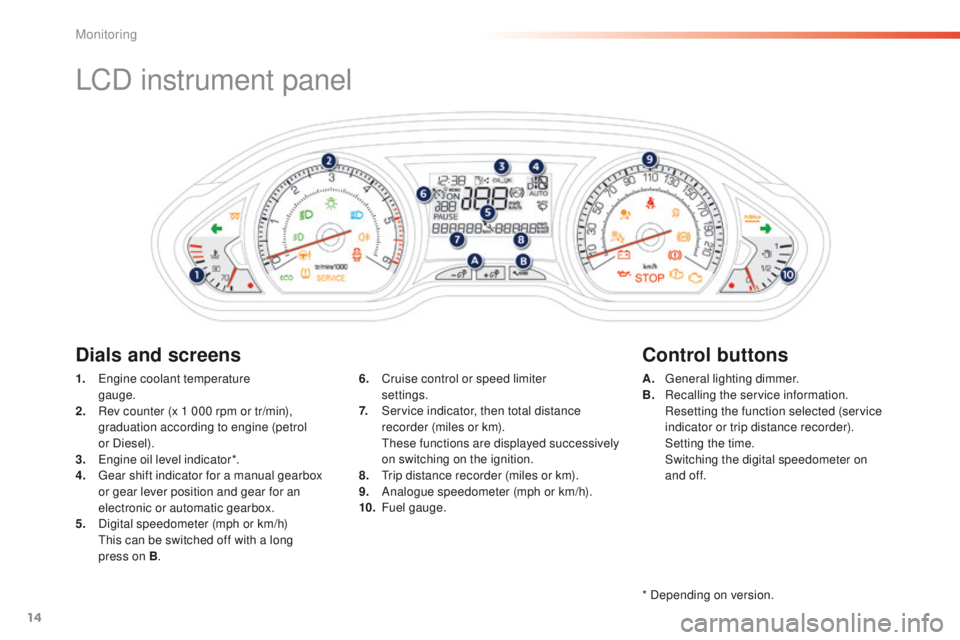
14
LCD instrument panel
1. Engine coolant temperature gauge.
2.
R
ev counter (x 1 000 rpm or tr/min),
graduation according to engine (petrol
or Diesel).
3.
E
ngine oil level indicator*.
4.
G
ear shift indicator for a manual gearbox
or gear lever position and gear for an
electronic or automatic gearbox.
5.
D
igital speedometer (mph or km/h)
T
his can be switched off with a long
press on B . A. G
eneral lighting dimmer.
B. R ecalling the service information.
R
esetting the function selected (service
indicator or trip distance recorder).
S
etting the time.
S
witching the digital speedometer on
and of f.
6. C
ruise control or speed limiter
settings.
7.
S
ervice indicator, then total distance
recorder (miles or km).
T
hese functions are displayed successively
on switching on the ignition.
8.
T
rip distance recorder (miles or km).
9.
A
nalogue speedometer (mph or km/h).
10.
F
uel gauge.
Dials and screens Control buttons
* Depending on version.
Monitoring
Page 23 of 450
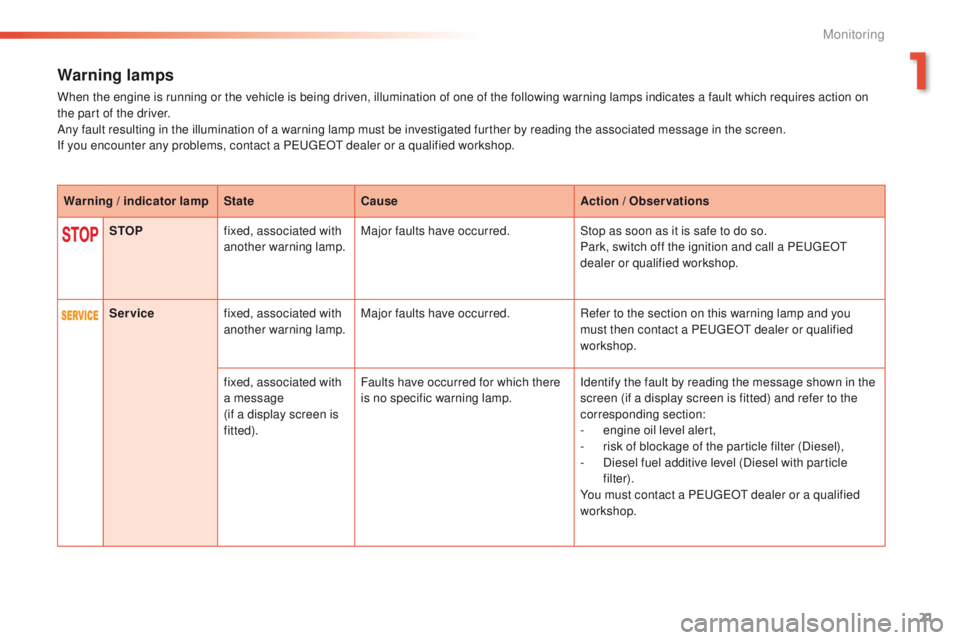
21
2008_en_Chap01_controle-de-marche_ed01-2016
Warning lamps
When the engine is running or the vehicle is being driven, illumination of one of the following warning lamps indicates a fault which requires action on
the part of the driver.
Any fault resulting in the illumination of a warning lamp must be investigated further by reading the associated message in the screen.
If you encounter any problems, contact a PEUGEOT dealer or a qualified workshop.Warning / indicator lamp StateCause Action / Observations
STOP fixed, associated with
another warning lamp. Major faults have occurred.
Stop as soon as it is safe to do so.
Park, switch off the ignition and call a PEUGEOT
dealer or qualified workshop.
Service fixed, associated with
another warning lamp. Major faults have occurred.
Refer to the section on this warning lamp and you
must then contact a PEUGEOT dealer or qualified
workshop.
fixed, associated with
a message
(if a display screen is
fitted). Faults have occurred for which there
is no specific warning lamp.
Identify the fault by reading the message shown in the
screen (if a display screen is fitted) and refer to the
corresponding section:
-
e
ngine oil level alert,
-
r
isk of blockage of the particle filter (Diesel),
-
D
iesel fuel additive level (Diesel with particle
filter).
You must contact a PEUGEOT dealer or a qualified
workshop.
1
Monitoring
Page 28 of 450
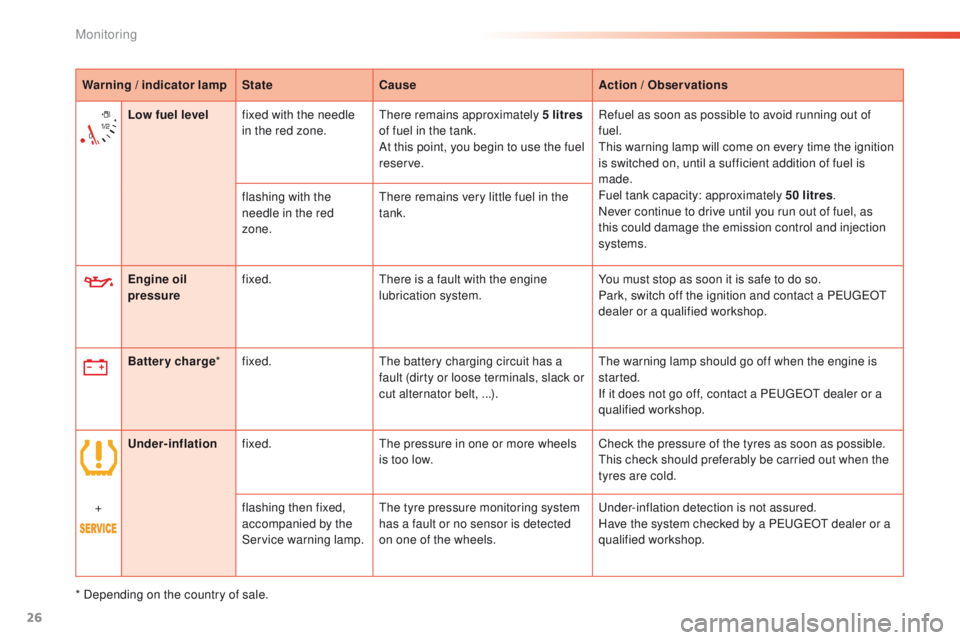
26
Warning / indicator lampStateCause Action / Observations
Engine oil
pressure fixed.
There is a fault with the engine
lubrication system. You must stop as soon it is safe to do so.
Park, switch off the ignition and contact a PEUGEOT
dealer or a qualified workshop.
Battery charge *fixed. The battery charging circuit has a
fault (dirty or loose terminals, slack or
cut alternator belt, ...). The warning lamp should go off when the engine is
started.
If it does not go off, contact a PEUGEOT dealer or a
qualified workshop.
Low fuel level
fixed with the needle
in the red zone. There remains approximately 5 litres
of fuel in the tank.
At this point, you begin to use the fuel
reserve. Refuel as soon as possible to avoid running out of
fuel.
This warning lamp will come on every time the ignition
is switched on, until a sufficient addition of fuel is
made.
Fuel tank capacity: approximately 50 litres
.
Never continue to drive until you run out of fuel, as
this could damage the emission control and injection
systems.
flashing with the
needle in the red
zone.
There remains very little fuel in the
tank.
Under-inflation fixed. The pressure in one or more wheels
is too low. Check the pressure of the tyres as soon as possible.
This check should preferably be carried out when the
tyres are cold.
+ flashing then fixed,
accompanied by the
Service warning lamp.The tyre pressure monitoring system
has a fault or no sensor is detected
on one of the wheels. Under-inflation detection is not assured.
Have the system checked by a PEUGEOT dealer or a
qualified workshop.
* Depending on the country of sale.
Monitoring
Page 33 of 450
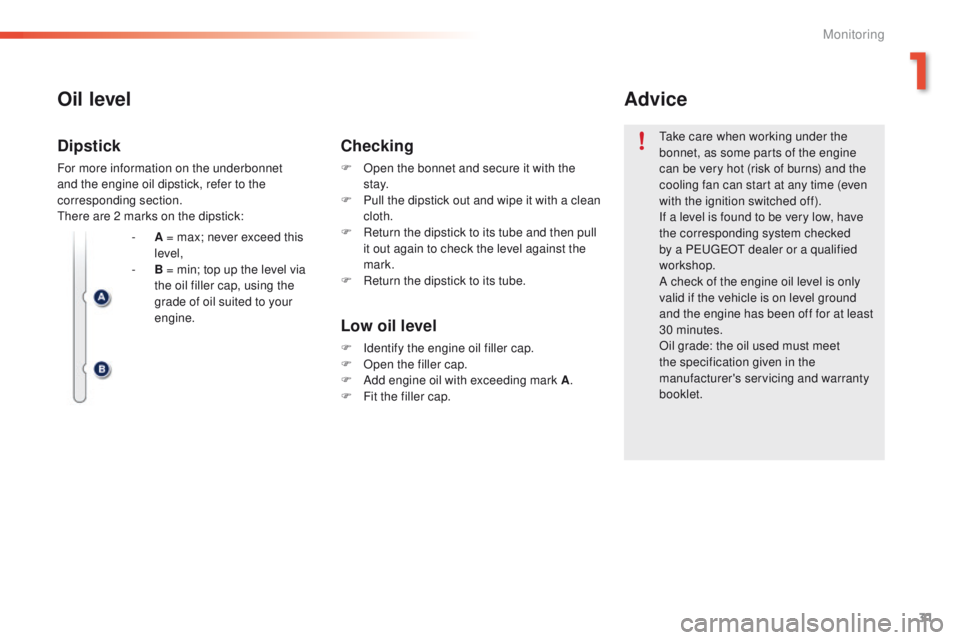
31
2008_en_Chap01_controle-de-marche_ed01-2016
Oil level
Low oil level
F Identify the engine oil filler cap.
F O pen the filler cap.
F
A
dd engine oil with exceeding mark A .
F
F
it the filler cap.
Dipstick
For more information on the underbonnet
and the engine oil dipstick, refer to the
corresponding section.
There are 2 marks on the dipstick: -
A
= max; never exceed this
level,
-
B
= min; top up the level via
the oil filler cap, using the
grade of oil suited to your
engine.
Checking
F Open the bonnet and secure it with the st ay.
F
P
ull the dipstick out and wipe it with a clean
cloth.
F
R
eturn the dipstick to its tube and then pull
it out again to check the level against the
mark.
F
R
eturn the dipstick to its tube.
Advice
Take care when working under the
bonnet, as some parts of the engine
can be very hot (risk of burns) and the
cooling fan can start at any time (even
with the ignition switched off).
If a level is found to be very low, have
the corresponding system checked
by a PEUGEOT dealer or a qualified
workshop.
A check of the engine oil level is only
valid if the vehicle is on level ground
and the engine has been off for at least
30 minutes.
Oil grade: the oil used must meet
the specification given in the
manufacturer's servicing and warranty
booklet.
1
Monitoring
Page 34 of 450
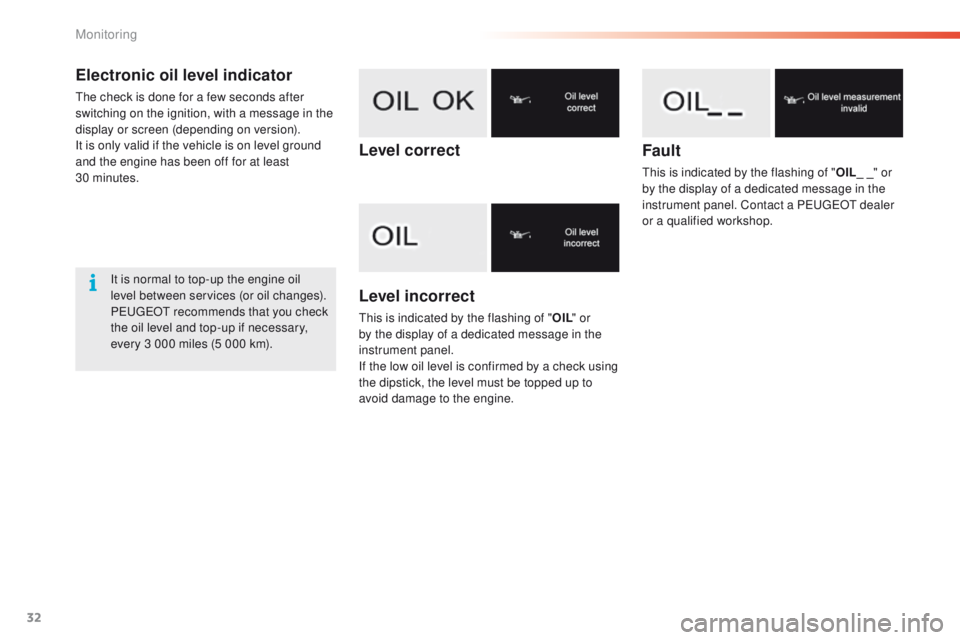
32
Electronic oil level indicator
The check is done for a few seconds after
switching on the ignition, with a message in the
display or screen (depending on version).
It is only valid if the vehicle is on level ground
and the engine has been off for at least
30
minutes.
It is normal to top-up the engine oil
level between services (or oil changes).
PEUGEOT recommends that you check
the oil level and top-up if necessary,
every 3 000 miles (5 000 km).
Fault
This is indicated by the flashing of " OIL_ _" or
by the display of a dedicated message in the
instrument panel. Contact a PEUGEOT dealer
or a qualified workshop.
Level correct
Level incorrect
This is indicated by the flashing of " OIL" or
by the display of a dedicated message in the
instrument panel.
If the low oil level is confirmed by a check using
the dipstick, the level must be topped up to
avoid damage to the engine.
Monitoring
Page 239 of 450
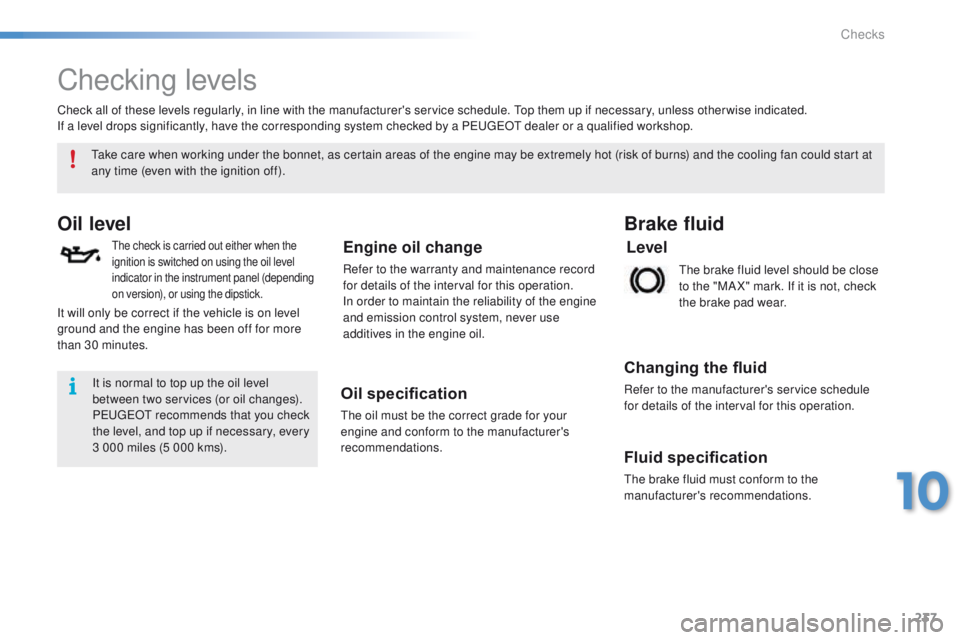
237
2008_en_Chap10_verifications_ed01-2016
Checking levels
Oil level
The check is carried out either when the
ignition is switched on using the oil level
indicator in the instrument panel (depending
on version), or using the dipstick.Engine oil change
Refer to the warranty and maintenance record
for details of the interval for this operation.
In order to maintain the reliability of the engine
and emission control system, never use
additives in the engine oil.
Oil specification
The oil must be the correct grade for your
engine and conform to the manufacturer's
recommendations.The brake fluid level should be close
to the "MA X" mark. If it is not, check
the brake pad wear.
Brake fluid
Changing the fluid
Refer to the manufacturer's service schedule
for details of the interval for this operation.
Take care when working under the bonnet, as certain areas of the engine may be extremely hot (risk of burns) and the cooling fan could start at
any time (even with the ignition off).
Check all of these levels regularly, in line with the manufacturer's service schedule. Top them up if necessary, unless other wise indicated.
If a level drops significantly, have the corresponding system checked by a PEUGEOT dealer or a qualified workshop.
It is normal to top up the oil level
between two services (or oil changes).
PEUGEOT recommends that you check
the level, and top up if necessary, every
3 000 miles (5 000 kms).
It will only be correct if the vehicle is on level
ground and the engine has been off for more
than 30 minutes.
Fluid specification
The brake fluid must conform to the
manufacturer's recommendations.
Level
10
Checks
Page 241 of 450
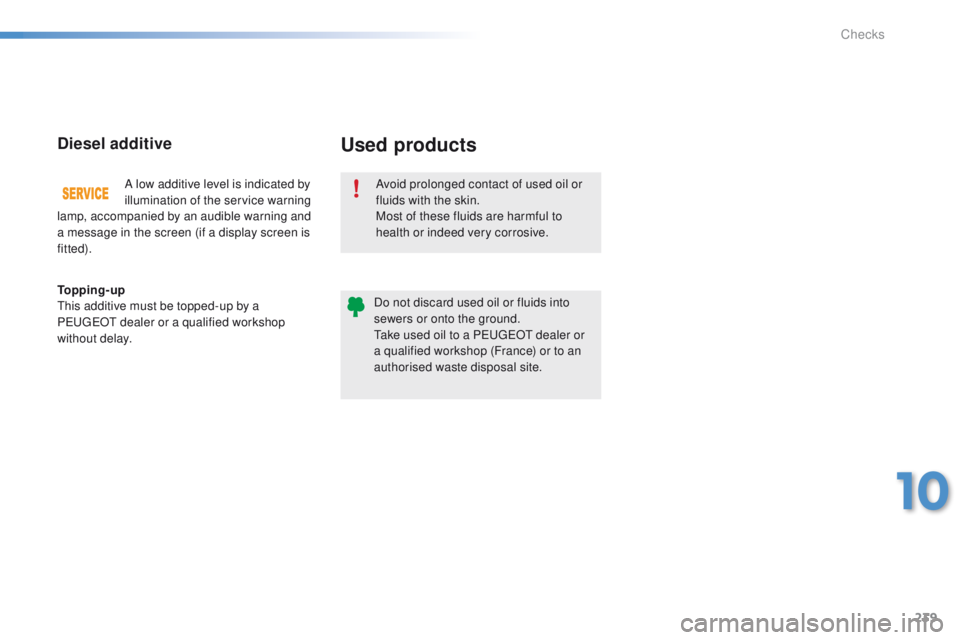
239
2008_en_Chap10_verifications_ed01-2016
Avoid prolonged contact of used oil or
fluids with the skin.
Most of these fluids are harmful to
health or indeed very corrosive.
Do not discard used oil or fluids into
sewers or onto the ground.
Take used oil to a PEUGEOT dealer or
a qualified workshop (France) or to an
authorised waste disposal site.
Used products
To p p i n g - u p
This additive must be topped-up by a
PEUGEOT dealer or a qualified workshop
without delay.
Diesel additive
A low additive level is indicated by
illumination of the service warning
lamp, accompanied by an audible warning and
a message in the screen (if a display screen is
fitted).
10
Checks
Page 242 of 450
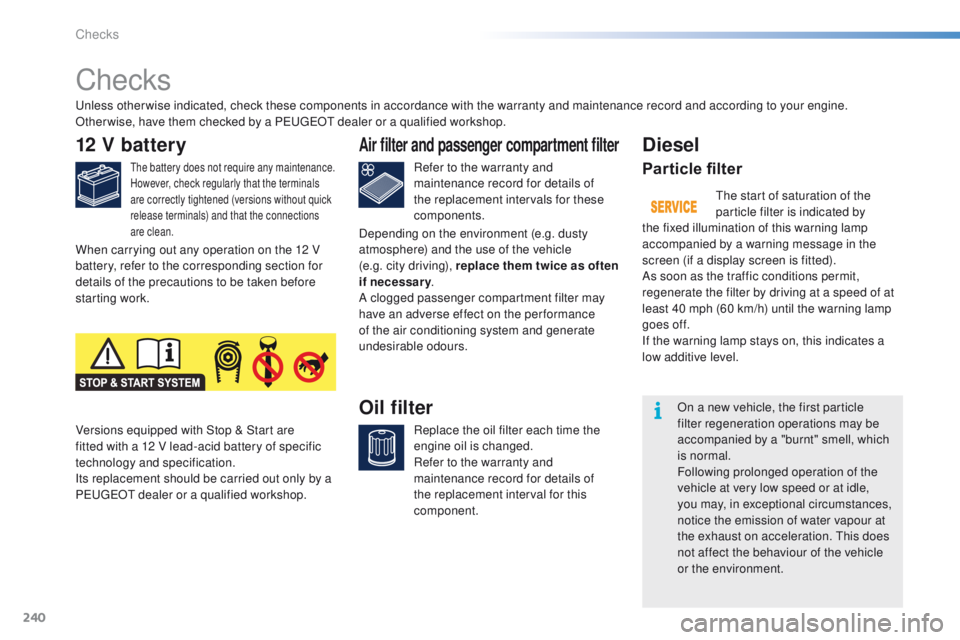
240
2008_en_Chap10_verifications_ed01-2016
Checks
12 V battery
The battery does not require any maintenance.
However, check regularly that the terminals
are correctly tightened (versions without quick
release terminals) and that the connections
are clean.
Versions equipped with Stop & Start are
fitted with a 12 V lead-acid battery of specific
technology and specification.
Its replacement should be carried out only by a
PEUGEOT dealer or a qualified workshop.
Diesel
Particle filter
On a new vehicle, the first particle
filter regeneration operations may be
accompanied by a "burnt" smell, which
is normal.
Following prolonged operation of the
vehicle at very low speed or at idle,
you may, in exceptional circumstances,
notice the emission of water vapour at
the exhaust on acceleration. This does
not affect the behaviour of the vehicle
or the environment.
Unless other wise indicated, check these components in accordance with the warranty and maintenance record and according to your engine.
Other wise, have them checked by a PEUGEOT dealer or a qualified workshop.
Air filter and passenger compartment filter
Refer to the warranty and
maintenance record for details of
the replacement intervals for these
components.
Oil filter
Replace the oil filter each time the
engine oil is changed.
Refer to the warranty and
maintenance record for details of
the replacement interval for this
component.
When carrying out any operation on the 12 V
battery, refer to the corresponding section for
details of the precautions to be taken before
starting work.
Depending on the environment (e.g. dusty
atmosphere) and the use of the vehicle
(e.g. city driving), replace them twice as often
if necessary
.
A clogged passenger compartment filter may
have an adverse effect on the per formance
of the air conditioning system and generate
undesirable odours. The start of saturation of the
particle filter is indicated by
the fixed illumination of this warning lamp
accompanied by a warning message in the
screen (if a display screen is fitted).
As soon as the traffic conditions permit,
regenerate the filter by driving at a speed of at
least 40 mph (60 km/h) until the warning lamp
goes off.
If the warning lamp stays on, this indicates a
low additive level.
Checks